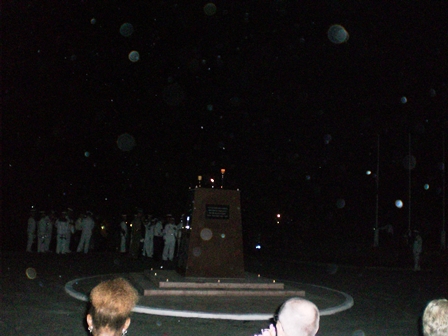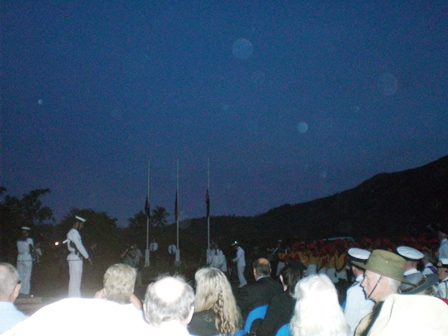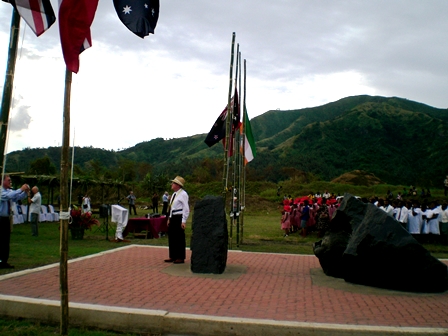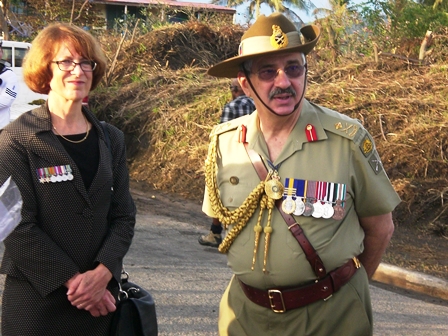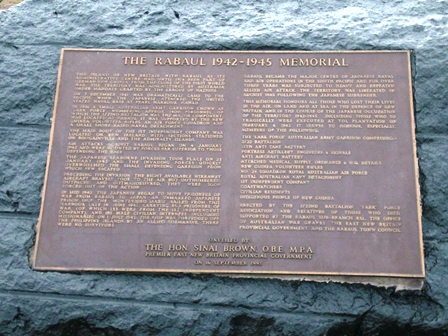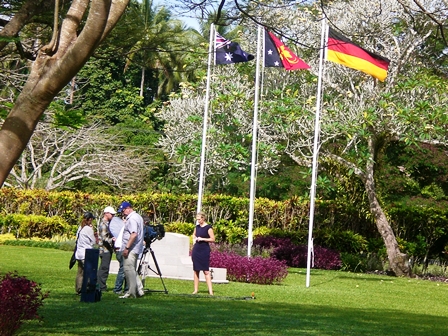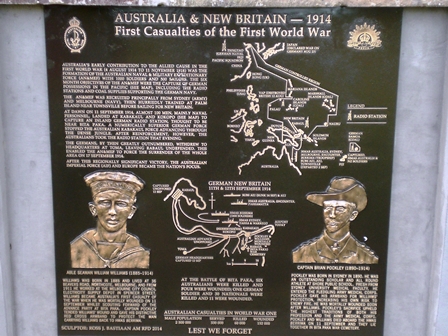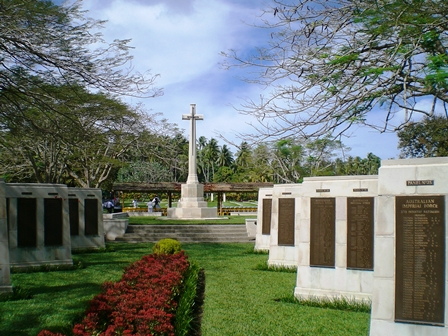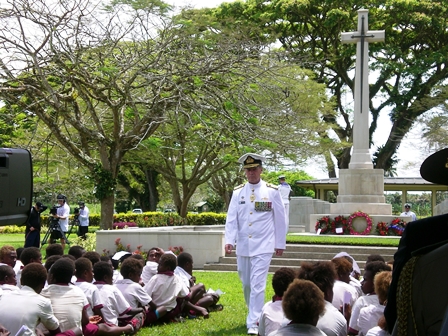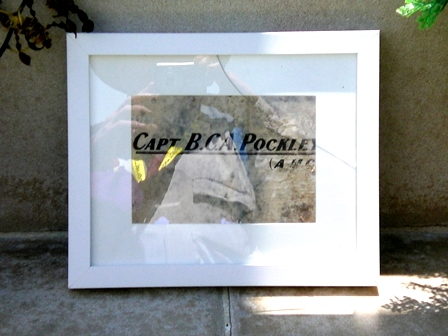Dressed with long trousers, ties and long sleeved shirts we left the Kokopo hotel at 0400 for the drive into Rabaul. The trip took about forty minutes. As we approached the cenotaph area, we drove down a flare lit road as the streets lights have not worked since the 1994 eruptions. The flares were made from large diameter bamboo stakes pushed into the sides of the roadway. The stakes stood about 1.5 metres high. In the top end of the bamboo stakes were inserted beer/soft drink cans that had had the tops cut open and into which had been placed kerosene and rags, before being lit.
We secured good central seats for the ceremony as the crowd gathered in the darkness with a few candles on the cenotaph which was located in front of the abandoned centre for administration site and the abandoned RSL club site. The seats were the same seats which had been used in the previous evening’s service. The catafalque party had been provided by HMAS Yarra. A small RAN band provided the music. A local school and church provided the choirs for the service. At 0500 the dawn service commenced.
After the service we strolled down to the Rabaul Yacht Club, for a gun fire breakfast. John with Sir Julius Chan’s brother Michael ensured that the Bundaberg Rum was properly enjoyed with the coffee. The Yacht Club put on a great breakfast for the crowd. The uniformed service members could not try the coffee with the rum as they to perform later on at the 1000 hours service at Bita Paka.
At about 0840 we departed the Rabaul Yacht Club and drove via Kokopo to the Bita Paka CWGC site for the ceremony. The road between Kokopo and Bita Paka is in good condition and we were informed that it has been laid over the 1914 dirt road.
When we arrived we immediately noticed that there were three flags flying; Papua New Guinea, Australia and Germany. The RAN white ensign was flying separately to the north of the site. A new curved wall with plaques explaining and commemorating the events of 1914 was on the northern end of the cemetery site. The wall had only been completed on the day before. The location of the 1914 wireless station was about 500 metres north west of the cemetery site.
Most of the seating area was covered by a thatched roof. The front rows of the seating were reserved for VIPs and descendents of the ANMEF. We occupied good central area covered seats. There was a well produced booklet on each seat as well as a bottle of water. The booklet contained the service as well as brief biographies of the fallen.
There was a gaggle of media representatives mainly from Australia. A descendent of Signalman Moffatt was there with his son. John showed him a copy of a recent Sydney newspaper article about the burial at sea of Moffatt. He came from Melbourne and had not seen the article and picture. He recorded an interview with John about the 11 September 1914 actions for radio.
The commemorative service commenced at exactly 1000. The catafalque party and flag orderlies were from by HMAS Yarra. The RAN band and soloist provided the music. Local schools provided the choir. The service was telecast live back to Australia.
Amongst the wreaths layers was the Honorary German Counsel. The descendent of Captain Brian Pockley laid a photo frame containing part of the shroud of Captain Pockley. Before the benediction the national anthems of Australia, Germany and Papua New Guinea were sung. Although the program booklet had the words “Deutschland, Deutschland uber alles” for the German National Anthem, the RAN soloist sang the current German National Anthem. The service finished exactly at 1100 due to the telecast.
After morning tea on the lawns to the north and outside the cemetery, we boarded our bus to return to the hotel at Kokopo by 1200 as the bus driver is only allowed an eight hour tasking. As we drove down the road, “BANG” sounded on the roof of the bus., a coconut had fallen and landed on the bus roof before rolling onto the roadway.
After lunch at the hotel, we sat around on the balcony over looking Blanche Bay, and had a group discussion about the actions and events of a hundred years ago. Some of the group walked around Kokopo town before dinner.
After dinner most of us went to bed early because of our early start that morning for the dawn service.
The weather was fine and sunny during the day.
